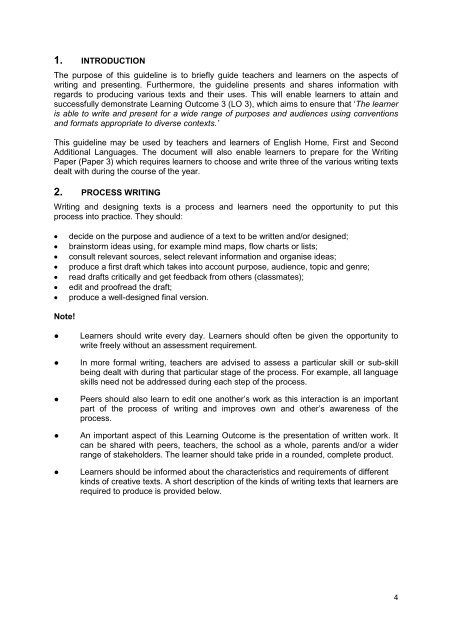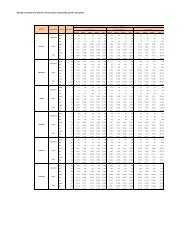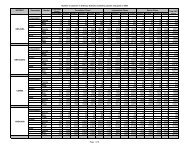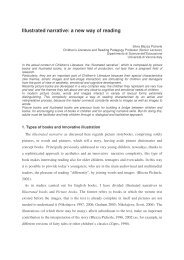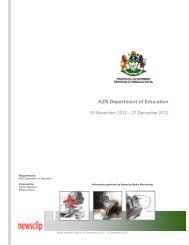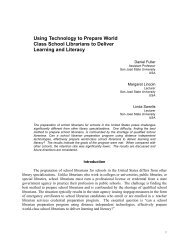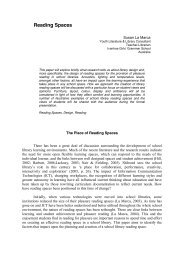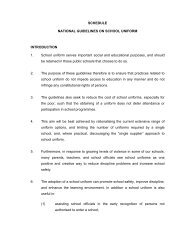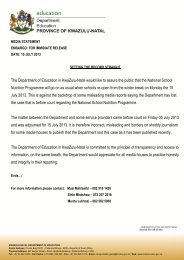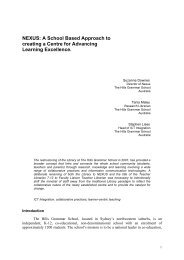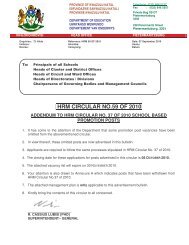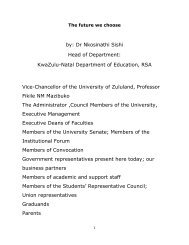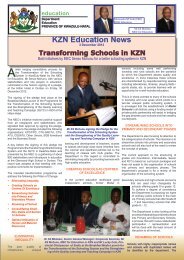GUIDELINE FOR TEACHING AND WRITING ESSAYS ... - Thutong
GUIDELINE FOR TEACHING AND WRITING ESSAYS ... - Thutong
GUIDELINE FOR TEACHING AND WRITING ESSAYS ... - Thutong
You also want an ePaper? Increase the reach of your titles
YUMPU automatically turns print PDFs into web optimized ePapers that Google loves.
1. INTRODUCTION<br />
The purpose of this guideline is to briefly guide teachers and learners on the aspects of<br />
writing and presenting. Furthermore, the guideline presents and shares information with<br />
regards to producing various texts and their uses. This will enable learners to attain and<br />
successfully demonstrate Learning Outcome 3 (LO 3), which aims to ensure that ‘The learner<br />
is able to write and present for a wide range of purposes and audiences using conventions<br />
and formats appropriate to diverse contexts.’<br />
This guideline may be used by teachers and learners of English Home, First and Second<br />
Additional Languages. The document will also enable learners to prepare for the Writing<br />
Paper (Paper 3) which requires learners to choose and write three of the various writing texts<br />
dealt with during the course of the year.<br />
2. PROCESS <strong>WRITING</strong><br />
Writing and designing texts is a process and learners need the opportunity to put this<br />
process into practice. They should:<br />
• decide on the purpose and audience of a text to be written and/or designed;<br />
• brainstorm ideas using, for example mind maps, flow charts or lists;<br />
• consult relevant sources, select relevant information and organise ideas;<br />
• produce a first draft which takes into account purpose, audience, topic and genre;<br />
• read drafts critically and get feedback from others (classmates);<br />
• edit and proofread the draft;<br />
• produce a well-designed final version.<br />
Note!<br />
●<br />
●<br />
●<br />
●<br />
●<br />
Learners should write every day. Learners should often be given the opportunity to<br />
write freely without an assessment requirement.<br />
In more formal writing, teachers are advised to assess a particular skill or sub-skill<br />
being dealt with during that particular stage of the process. For example, all language<br />
skills need not be addressed during each step of the process.<br />
Peers should also learn to edit one another’s work as this interaction is an important<br />
part of the process of writing and improves own and other’s awareness of the<br />
process.<br />
An important aspect of this Learning Outcome is the presentation of written work. It<br />
can be shared with peers, teachers, the school as a whole, parents and/or a wider<br />
range of stakeholders. The learner should take pride in a rounded, complete product.<br />
Learners should be informed about the characteristics and requirements of different<br />
kinds of creative texts. A short description of the kinds of writing texts that learners are<br />
required to produce is provided below.<br />
4


